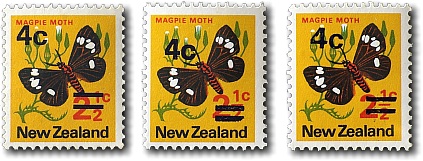
1971 Provisionals
«previous next»

| Cat. | Mint Unhinged | Fine Used | ||||
| 4c | Overprinted on 2½c Magpie Moth (Simplified) | 177a | $0.45 | $0.45 | ||
| (i) London Recess Print | 177a1 | $0.45 | $0.45 | |||
| (ii) London Surface Print (Issued 1972) | 177a2 | $0.55 | $0.45 | |||
| (iii) Local Surface Print (Issued 1973) | 177a3 | $0.90 | $0.45 | |||
To handle the three different cases required three different processes, which resulted in three varieties:
The imperforate sheets were surcharged in England by photogravure (recess printing) after which they were perforated and cut into sheets in the usual way. This stamp has two thin horizontal bars and can be distinguished from the other two varieties by the high quality of the photogravure printing process and the screen dots which give the diagonal portion of the 4 a stepped or almost digitised effect under a magnifying glass (177a1 - left-most in the photos).
The stamps that had already been perforated at the printers could not be surcharged with photogravure as the gripping edges had already been trimmed so they had to be surcharged by letterpress (surface printing). This stamp is the most easily identified as the horizontal bars are thicker and fairly poorly printed. (177a2 - middle in both photos)
The stamps distributed around Post Offices were returned to the New Zealand Government Printer and surcharged locally by letterpress. The local print stamp also has two thin horizontal bars but can be distinguished from the recess printed stamp by the poor quality of the letterpress printing process. (177a3 - right-most in both photos)

Bibliography
The Postage Stamps of New Zealand Volume VI
Edited by D. E. G. Naish FRPSNZ and K. J. McNaught FRPSNZ FRPSL
Publsihed 1975 by The Royal Philatelic Society of New Zealand Incorporated
Pages 124 - 135
Catalogue ·
1970 ·
1971 ·
1972 ·
Definitives
Order Form · Currency Converter · Privacy Policy
What to Expect · Contact Us · Links
Order Form · Currency Converter · Privacy Policy
What to Expect · Contact Us · Links
Wishing you a Merry Christmas and a Happy and Prosperous New Year
This page was last updated on 28 Dec 2025
All content and images copyright © 2008 - 2025 StampsNZ
This page was last updated on 28 Dec 2025
All content and images copyright © 2008 - 2025 StampsNZ